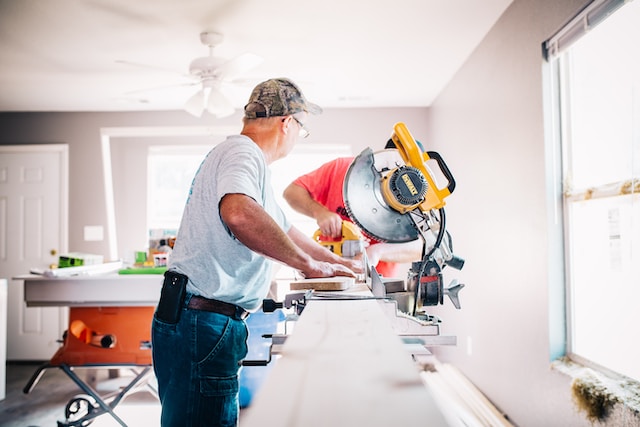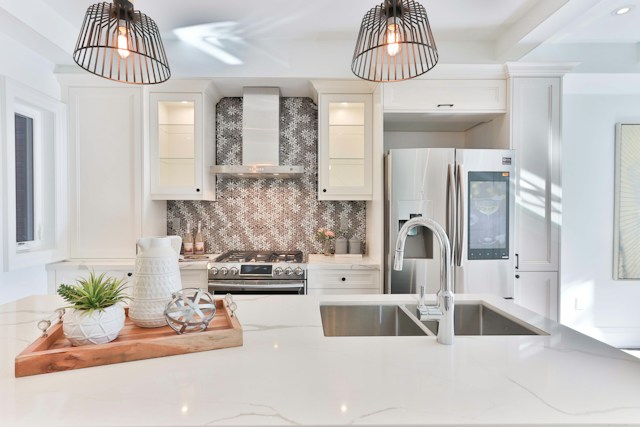
Choosing the right kitchen worktops is a critical decision that combines practicality with aesthetic appeal. This guide aims to provide an in-depth look at the various materials available, helping you select a worktop that not only meets your design needs but also stands up to the demands of daily kitchen activities.
Quartz is an excellent option for those prioritising durability and hygiene. Its non-porous nature resists stains and bacteria, and it comes in various colours to match any kitchen style.
Laminate worktops are a budget-friendly alternative that doesn’t skimp on style. Advances in HD printing have enabled laminates to convincingly mimic the look of wood or stone, offering a high-end appearance without the associated costs.
For a natural aesthetic, wood worktops provide timeless charm and natural antibacterial properties. On the other hand, granite is a top choice for its heat and scratch resistance, adding a luxurious feel to your kitchen.
The Process of Kitchen Worktops Manufacturing
Understanding the strengths of each material will help you make a choice that ensures your kitchen worktop is both functional and visually appealing.
| Worktop Material | Manufacturing Process |
|---|---|
| Quartz | Begins with crushed stone mixed with polymer resins and color pigments. The mixture is poured into slabs and heated in a kiln, then compressed into a solid, non-porous surface. Slabs are cut to size, polished, and sealed for installation. |
| Laminate | Constructed from composite timber particles with a decorative overlay. High-pressure heat forms the overlay, creating a surface that can mimic various textures and designs. Modern HD printing technology is used for realistic patterns and colors. |
| Wood | Timber, such as oak or maple, is selected and cut into large slabs. The wood is then sanded, treated, and sealed with non-toxic oils to enhance durability and provide antibacterial properties. Care is taken to minimize wood’s natural tendency to expand and contract with temperature changes. |
| Granite | Mined from quarries in large blocks, granite is then cut into slabs. These slabs undergo a process of cutting, polishing, and shaping in fabrication shops. After being tailored to specific kitchen measurements, the granite is sealed to make it non-porous before installation. |
| Corian | Made from a mixture of acrylic polymer and minerals. The material is cast into sheets, which can then be thermoformed into various shapes and designs. It offers a warm surface with a subtle luster and can be customized with features like built-in charging or LED lighting. |
Quartz
Quartz’s extreme hardness and strength, designed to withstand heat, scratching, and denting, make it a popular worktop material in busy households. Furthermore, its non-porous nature ensures it doesn’t harbour bacteria or viruses, an asset for kitchen environments in which food preparation takes place.
To create a quartz worktop, manufacturers begin with crushed stone that has been mixed together with polymer resins as a binding agent and colour pigments to give it its desired hue. At this stage, manufacturers may add extra minerals or materials for special effects, like metal flecks or recycled mirrors for additional character and charm in their finished worktop.
After mixing and pouring into a slab, we combine and heat the ingredients in a large kiln to compress and compact the quartz into an inert, solid surface. Before installation, the manufacturer will polish the non-porous surface to size and cut it for further polishing and cutting. Before installation, your manufacturer will create custom shapes using your kitchen measurements to cut out appliances as needed.
After cutting the worktops to shape, it is necessary to seal them to prevent leaks and ensure non-porous surfaces that protect against bacteria and germs. Quartz also resists staining, an advantage that makes this material ideal for families with young children or pet owners.
Quartz may not be as hard-wearing as granite, but it is much less susceptible to cracking and chipping. Plus, regular cleaning with warm, soapy water often suffices to maintain its beauty. These qualities help make quartz countertops so popular these days, especially among those focused on simplifying their lives and looking for surfaces that reflect this. If you are interested in purchasing one for yourself, Rearo provides free consultations without obligation.

Laminate
Laminate worktops are an economical and stylish choice, featuring non-porous construction that boasts decorative designs in an array of non-plain colours and designs that mimic other surface materials, from wood to natural stone. Laminate has long been considered plain-coloured, but thanks to HD printing techniques, strikingly realistic images are now possible that appear almost indistinguishable from real surfaces. Laminate is durable and water-resistant, with minimal scratch or burn risks and easy cutting capabilities for installation in standard kitchen installations, saving both costs and time! Additionally, many reliable kitchen worktops brands provide upstands and splashbacks to complete the look for seamless aesthetic continuity when creating a cohesive look throughout.
If you want a high-end designer look without breaking the bank, opt for granite-look laminate surfaces. Combining quality composite timber particles with a decorative overlay, it is constructed by heat-forming under high pressure. Offered in attractive finishes and textures that mimic marble, quartz, and wood finishes—plus antibacterial protection too—laminates offer hardwearing, water-resistant finishes with antibacterial finishes as well as being hard-wearing, durable surfaces suitable for cutting or chopping tasks.
Corian’s composition of acrylic polymer and minerals produces a warm surface with a subtle natural lustre, providing comfortable warmth to the touch and an expansive colour selection that simplifies matching any kitchen scheme, from contemporary rooms with bright hues to traditional spaces with soft tones. Additionally, Corian can be thermoformed into organic curves for breakfast bars or wraparound surfaces on islands, engraved, back-lit with LED lights, or fitted with built-in wireless charging capabilities for smart devices.
Quartz may be an exceptional investment for those with the means, but alternative materials can often be more economical. Homeowners can customise solid-surface Corian with integral sinks and coloured edges to match a range of kitchen colours, making it an economical choice.
Wood is a budget-conscious alternative with no significant maintenance needs; professional fitters install it in large slabs. When selected properly and secured with FSC-certified timber like oak or iroko, it will last years with minimal upkeep required.
Wood
Wood has long been one of the go-to materials for kitchen worktops in both traditional and contemporary settings, making an appearance in both country cottage kitchens as well as sleek modern slab doors. It is available in an assortment of shades and colours. Oak, luxurious dark walnut, and light maple are just a few examples of beautiful timbers available to craft durable worktops from. Wood’s natural antibacterial qualities make it an excellent choice for families concerned about germs in the kitchen; ensuring proper sealing with non-toxic oil resists the absorption of bacteria and keeps it clean!
When purchasing and installing wood worktops, it is important to take care because you can easily sand and re-oil them to remove scratches, marks, and stains. When choosing solid wood worktops, carefully select them from suppliers before professional kitchen fitters install them; it is also advisable to have your worktop templated prior to cutting to ensure a precise fit to the dimensions of your kitchen.
Wood reacts to changes in temperature and humidity over time, expanding and contracting slightly with each change, sometimes dramatically (called bowing). To minimise bowing effects, always use slotted angle brackets with slots running across rather than along the grain to allow horizontal expansion. To prevent cracking, pilot drill your worktop and use washers alongside brackets to complete the installation.
Wood worktops should be protected with topOil or PolyXoil by Osmo or HaBiol to safeguard them against moisture, staining, and mould. Experts recommend applying the protective coating at least once annually as varnishes, waxes, or mineral oils do not offer sufficient protection.
Granite
Granite worktops have quickly become one of the most sought-after work surfaces for kitchens over the past few decades. Crafted over millions of years from compressed molten rock beneath Earth’s surface, granite countertops boast greater heat resistance and durability compared to marble or synthetic materials, not to mention an elegant natural aesthetic that resists staining and scratching damage.
Granite originates from quarries around the globe, where miners extract the stone in huge blocks and cut it into slabs for processing and shaping into countertops. Once cut into slabs, this process moves on to fabrication shops for polishing and shaping into countertops, though it is not an overnight process. To achieve beautiful granite countertops, it requires considerable labour on behalf of fabricator shops as well.
Bridge saws cut slabs of granite into custom sizes for countertops and polish them using diamond pads ranging from rougher ones up to finer ones, providing shine while protecting against acid or hot pan stains.
After cutting and drilling to fit sinks or other cut-outs that make up their kitchen design, the workers will seal the granite to make it non-porous, preventing bacteria from growing within its cracks.
After the sealant sets, you can install granite in your home. After carefully lifting it over cabinets, secure the granite to walls and floors with silicone sealant before caulking the seams between the granite and cabinets for further sealing.
Granite worktops add luxuriousness and can increase property values significantly when selling a property.

Eugene is an environmental journalist with a focus on fisheries and aquatic biodiversity. Her work centers on exploring the balance between fishing industries and marine conservation, offering insights into policies, innovations, and sustainability challenges.
